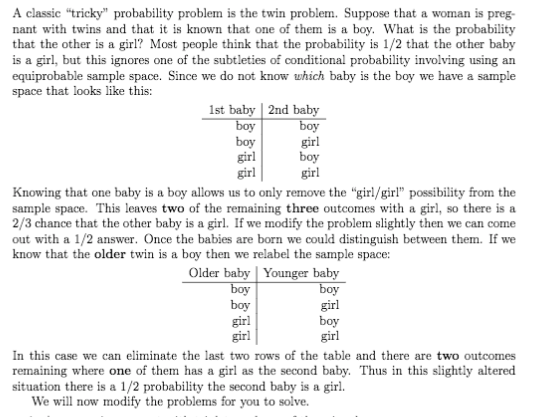2. A woman has given birth to triplets and the oldest one is a boy. (a) Create a sample space for the possible outcomes of boy versus girl (initially ignore that you know the oldest is a boy). (b) What outcomes or outcomes are eliminated by knowing that the oldest of the babies is a boy? (c) Give the probability that at least one of the remaining babies is a girl.
2. A woman has given birth to triplets and the oldest one is a boy. (a) Create a sample space for the possible outcomes of boy versus girl (initially ignore that you know the oldest is a boy). (b) What outcomes or outcomes are eliminated by knowing that the oldest of the babies is a boy? (c) Give the probability that at least one of the remaining babies is a girl.
Holt Mcdougal Larson Pre-algebra: Student Edition 2012
1st Edition
ISBN:9780547587776
Author:HOLT MCDOUGAL
Publisher:HOLT MCDOUGAL
Chapter11: Data Analysis And Probability
Section11.8: Probabilities Of Disjoint And Overlapping Events
Problem 2C
Related questions
Question

Transcribed Image Text:2. A woman has given birth to triplets and the oldest one is a boy.
(a) Create a sample space for the possible outcomes of boy versus girl (initially ignore
that you know the oldest is a boy).
(b) What outcomes or outcomes are eliminated by knowing that the oldest of the
babies is a boy?
(c) Give the probability that at least one of the remaining babies is a girl.

Transcribed Image Text:A classic "tricky" probability problem is the twin problem. Suppose that a woman is preg-
nant with twins and that it is known that one of them is a boy. What is the probability
that the other is a girl? Most people think that the probability is 1/2 that the other baby
is a girl, but this ignores one of the subtleties of conditional probability involving using an
equiprobable sample space. Since we do not know which baby is the boy we have a sample
space that looks like this:
1st baby | 2nd baby
boy
boy
girl
girl
boy
girl
boy
girl
Knowing that one baby is a boy allows us to only remove the "girl/girl" possibility from the
sample space. This leaves two of the remaining three outcomes with a girl, so there is a
2/3 chance that the other baby is a girl. If we modify the problem slightly then we can come
out with a 1/2 answer. Once the babies are born we could distinguish between them. If we
know that the older twin is a boy then we relabel the sample space:
Older baby | Younger baby
boy
boy
girl
girl
boy
girl
boy
girl
In this case we can eliminate the last two rows of the table and there are two outcomes
remaining where one of them has a girl as the second baby. Thus in this slightly altered
situation there is a 1/2 probability the second baby is a girl.
We will now modify the problems for you to solve.
Expert Solution
This question has been solved!
Explore an expertly crafted, step-by-step solution for a thorough understanding of key concepts.
This is a popular solution!
Trending now
This is a popular solution!
Step by step
Solved in 5 steps

Knowledge Booster
Learn more about
Need a deep-dive on the concept behind this application? Look no further. Learn more about this topic, probability and related others by exploring similar questions and additional content below.Recommended textbooks for you

Holt Mcdougal Larson Pre-algebra: Student Edition…
Algebra
ISBN:
9780547587776
Author:
HOLT MCDOUGAL
Publisher:
HOLT MCDOUGAL

Holt Mcdougal Larson Pre-algebra: Student Edition…
Algebra
ISBN:
9780547587776
Author:
HOLT MCDOUGAL
Publisher:
HOLT MCDOUGAL